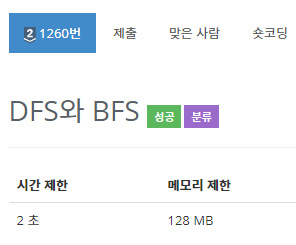문제

그래프를 DFS로 탐색한 결과와 BFS로 탐색한 결과를 출력하는 프로그램을 작성하시오
문제접근
- DFS와 BFS의 개념을 배운 뒤 코드 패턴을 연습해볼 수 있는 기본 문제다.
- 인접행렬보다는 인접리스트를 사용하는 것에 익숙해지는 것이 효율적이다.
- DFS와 BFS는 어느정도 패턴이 존재하므로 이번 기회에 익숙해지는 것이 좋다.
코드
#include <iostream>
#include <vector>
#include <queue>
#include <algorithm>
using namespace std;
static int N, M, startVertex;
static vector<bool> isVisited(1001);
static vector<int> graph[1001];
void dfs(int here) {
cout << here << ' ';
isVisited[here] = true;
for (const int& there : graph[here])
if (!isVisited[there]) dfs(there);
}
void bfs(int here) {
queue<int> q;
isVisited[here] = true;
q.push(here);
while (!q.empty()) {
int curVertex = q.front(); q.pop();
cout << curVertex << ' ';
for (const int& there : graph[curVertex]) {
if (!isVisited[there]) {
isVisited[there] = true;
q.push(there);
}
}
}
}
int main() {
ios::sync_with_stdio(false); cin.tie(nullptr); cout.tie(nullptr);
cin >> N >> M >> startVertex;
for (int i = 0; i < M; ++i) {
int startV = 0, endV = 0; cin >> startV >> endV;
graph[startV].push_back(endV);
graph[endV].push_back(startV);
}
for (int i = 1; i <= N; ++i) sort(begin(graph[i]), end(graph[i]));
dfs(startVertex); cout << '\n';
isVisited.assign(N, false);
bfs(startVertex); cout << '\n';
}- 무방향 그래프이므로 입력받을 때 양쪽 정점에서 시작하는 간선을 생성해야한다.
- 방문할 수 있는 정점이 여러 개인 경우에는 정점 번호가 작은 것을 먼저 방문해야하므로 각 정점에 대해
sort()함수를 사용해야 함을 주의하자. - DFS를 수행한 뒤에는 전역변수를 초기화해줘야 한다.
fill()함수 또는assign()함수를 사용해야 한다.
결과

